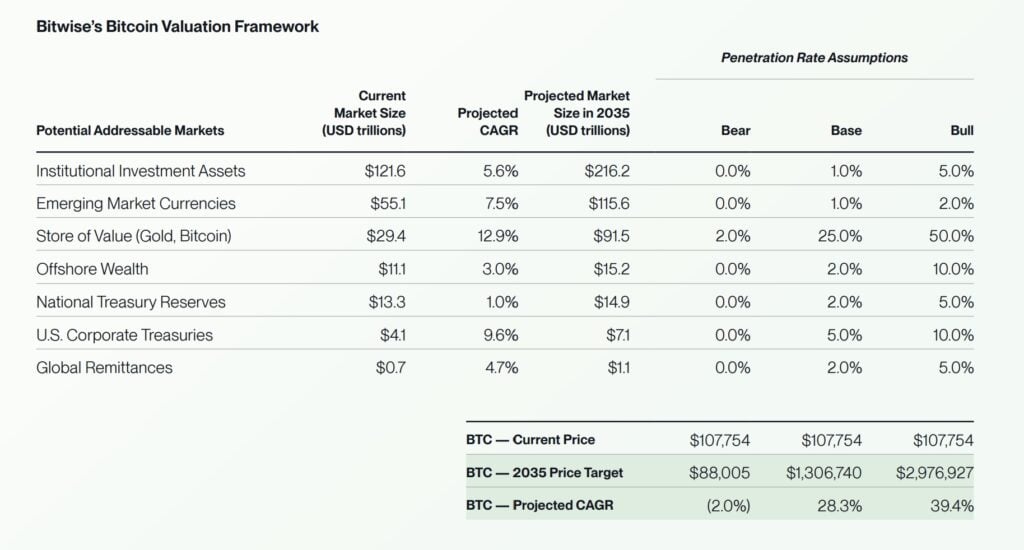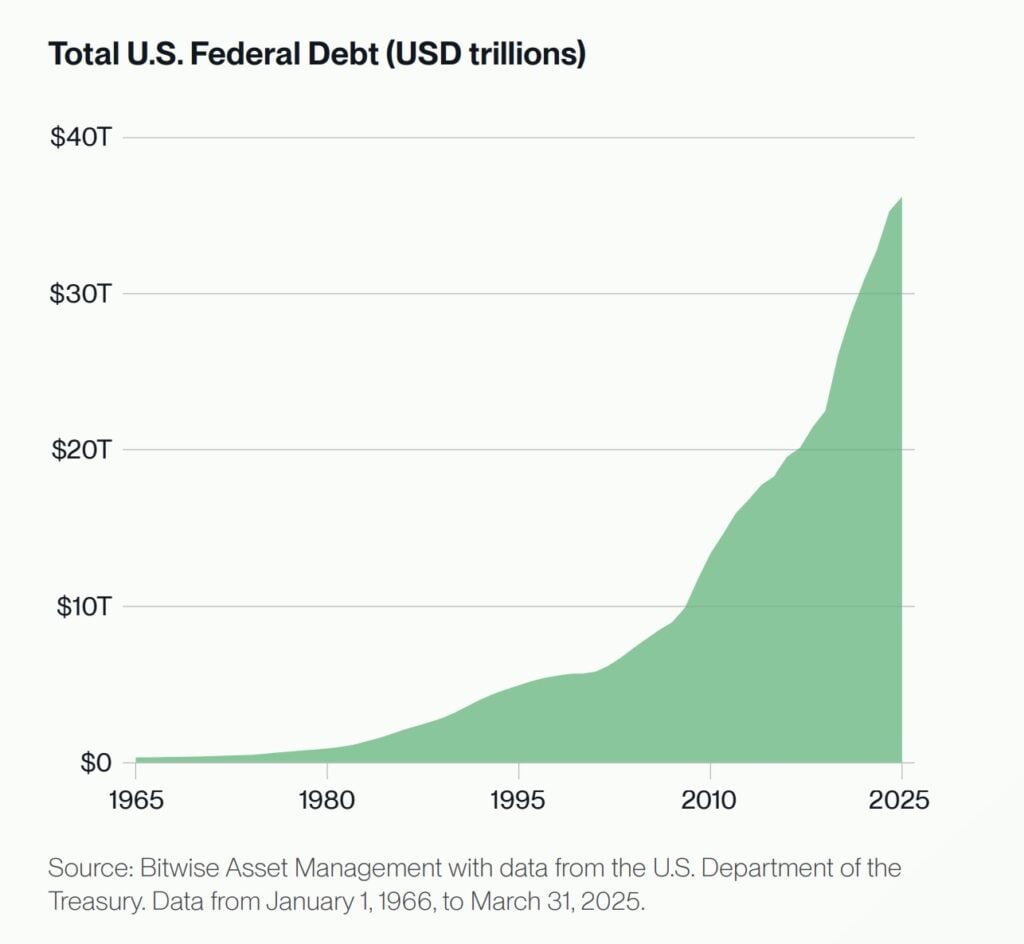
Their reasoning? The same trio of forces that have always been there but are finally converging in a way that institutions can’t ignore: inelastic supply, accelerating institutional adoption, and a macro backdrop that makes fiat look like a burning ship.
The Numbers: Bitwise’s Bold Math
Bitwise’s newly published “Long-Term Capital Market Assumptions” models Bitcoin at a 28.3% compound annual growth rate (CAGR) — crushing equities (6.2%), bonds (4%), and even gold (3.8%). If that holds, BTC is trading around $1.3 million by 2035.
But the firm doesn’t just give one number; they lay out scenarios:
Bull case: $2.97M BTC (39.4% CAGR) Base case: $1.3M BTC (28.3% CAGR) Bear case: $88,005 BTC (2% CAGR)Even the “bear” outcome looks more like a healthy 401(k) than a crypto apocalypse.

Bitcoin Valuation Framework. Source: Bitwise
Institutions Are the New Whales
Retail may have birthed Bitcoin, but institutions are now running the show. Bitwise analysts Matt Hougan, Ryan Rasmussen, Josh Carlisle, Mallika Kolar, Andre Dragosch, and Juan Leon note that over 75% of Coinbase’s trading volume now comes from institutions. That’s Wall Street, pensions, and corporate treasuries, not Reddit day traders.
And the flows are staggering. Demand is outstripping new supply six to one. Daily mining produces ~450 BTC, while institutions have been known to yank 2,500 BTC in just 48 hours. The math isn’t subtle: supply and demand are on a collision course.
Corporate adoption underscores this shift: 35 publicly traded firms now hold over 1,000 BTC each, up from 24 earlier this year. Corporate purchases surged 35% in Q2 2025 alone, jumping from 99,857 BTC to 134,456 BTC.
And then there’s MicroStrategy — still the apex predator. Michael Saylor’s firm added again in August, bringing its holdings to 632,457 BTC worth $71 billion. They’re sitting on $25 billion in unrealized gains, a 53% paper profit.
The Scarcity Story: It’s Not Just Hype
By 2032, Bitcoin’s annual issuance drops from 0.8% to 0.2%. That’s basically monetary starvation compared to fiat’s all-you-can-print buffet. Already, 94.8% of all BTC is in circulation, and roughly 70% hasn’t moved in a year. HODL culture isn’t just a meme; it’s a structural bottleneck.
As Bitwise bluntly puts it:
“The inelastic supply of Bitcoin, combined with continued demand growth, is the single most important driver of our long-term assumptions.”
Translation: no matter how high the price goes, miners can’t — and won’t — turn the spigot faster.
Macro: Fiat Is the Weak Link
If Bitcoin is sound money, fiat is increasingly unsound. The U.S. federal debt ballooned $13 trillion in five years, now sitting at $36.2 trillion. Annual interest payments? Nearly $1 trillion — the fourth-largest line item in the federal budget.
And here’s the kicker: interest costs are now outpacing GDP growth. That’s like running on a treadmill that speeds up every minute while you get more tired. Eventually, you fall.
Against that backdrop, Bitcoin looks less like a speculative toy and more like an insurance policy — the hardest asset in an age of monetary softness.

US federal debt data. Source: Bitwise
Perfect Storm, Perfect Setup
So here’s where we stand:
Supply locked. Institutions hoarding. Macro cracking.Miners trickle out 450 BTC daily while institutions routinely hoover up multiples of that in hours. The imbalance isn’t theoretical anymore — it’s visible on-chain.
Bitwise’s $1.3M by 2035 might sound outrageous, but the setup is simple math plus simple human behavior. Scarcity, meet greed.


 2 hours ago
4
2 hours ago
4 










 Bengali (Bangladesh) ·
Bengali (Bangladesh) ·  English (United States) ·
English (United States) ·